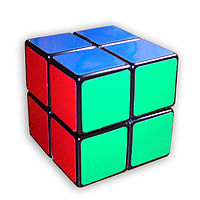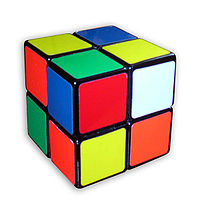Pocket Cube: Difference between revisions
Vit Platina (talk | contribs) No edit summary |
m Bot: references tag position |
||
| Line 97: | Line 97: | ||
==Methods== |
==Methods== |
||
There are several commonly used speed methods on the 2×2×2. The two most popular 2×2×2 specific speed methods are the Guimond and Ortega methods.{{Citation needed|date=February 2010}} Both of these methods have been proven to have the potential to break 5 seconds on average. Extremely fast but algorithm-heavy methods include the Stern-Sun (SS), Erik-Gunnar (EG), and CLL methods. |
There are several commonly used speed methods on the 2×2×2. The two most popular 2×2×2 specific speed methods are the Guimond and Ortega methods.{{Citation needed|date=February 2010}} Both of these methods have been proven to have the potential to break 5 seconds on average. Extremely fast but algorithm-heavy methods include the Stern-Sun (SS), Erik-Gunnar (EG), and CLL methods. |
||
==References== |
|||
| ⚫ | |||
==See also== |
==See also== |
||
| Line 109: | Line 112: | ||
{{Rubik's Cube}} |
{{Rubik's Cube}} |
||
| ⚫ | |||
[[Category:Rubik's Cube]] |
[[Category:Rubik's Cube]] |
||
Revision as of 19:46, 9 July 2011
This article needs additional citations for verification. (October 2009) |

The Pocket Cube (also known as the Mini Cube or the Ice Cube) is the 2×2×2 equivalent of a Rubik's Cube. The cube consists of 8 pieces, all corners.
Permutations



Any permutation of the eight corners is possible (8! positions), and seven of the them can be independently rotated (37 positions). There is nothing identifying the orientation of the cube in space, reducing the positions by a factor of 24. This is because all 24 possible positions and orientations of the first corner are equivalent due to the lack of fixed centers. This factor does not appear when calculating the permutations of N×N×N cubes where N is odd, since those puzzles have fixed centers which identify the cube's spatial orientation. The number of possible positions of the cube is
The maximum number of turns required to solve the cube is up to 11 full turns, or up to 14 quarter turns.[1]
The number f of positions that require n full twists and number q of positions that require n quarter turn twists are:
| n | f | q |
|---|---|---|
| 0 | 1 | 1 |
| 1 | 9 | 6 |
| 2 | 54 | 27 |
| 3 | 321 | 120 |
| 4 | 1847 | 534 |
| 5 | 9992 | 2256 |
| 6 | 50136 | 8969 |
| 7 | 227536 | 33058 |
| 8 | 870072 | 114149 |
| 9 | 1887748 | 360508 |
| 10 | 623800 | 930588 |
| 11 | 2644 | 1350852 |
| 12 | 0 | 782536 |
| 13 | 0 | 90280 |
| 14 | 0 | 276 |
Records

Erik Akkersdijk holds the current world record of solving the Pocket Cube in competition, with a time of 0.96 seconds set at the Geneva Open 2008. Rowe Hessler tied this record at the US Nationals 2010. For the best average time of 5 solves, Feliks Zemdegs holds the world record with a time of 2.12 seconds set at Melbourne Cube day 2010.[2]
Variants
At Rubik's online store, an easier version of the Pocket Cube exists, dubbed the "Junior Cube". This version has only two colors, with a picture of a monkey on one face.
The Rubik's Ice Cube is a version of the Pocket Cube with transparent plastic and translucent stickers. It comes with a clear blue, ice-like display base.
The Eastsheen company produces a variation as well. It has a different turning mechanism and is noticeably larger (5 cm (2.0 in)) than the original.
Verdes Innovations has released the V-Cube 2, which is available in two shapes. The flat-sided V-Cube 2 is roughly the same size as the Eastsheen cube. The V-Cube 2b has a rounded shape like the V-Cube 7.
Methods
There are several commonly used speed methods on the 2×2×2. The two most popular 2×2×2 specific speed methods are the Guimond and Ortega methods.[citation needed] Both of these methods have been proven to have the potential to break 5 seconds on average. Extremely fast but algorithm-heavy methods include the Stern-Sun (SS), Erik-Gunnar (EG), and CLL methods.
References
See also
- Pyramorphix, a pyramidal puzzle that uses the same mechanism
- Rubik's Cube (3×3×3)
- Rubik's Revenge (4×4×4)
- Professor's Cube (5×5×5)
- V-Cube 6 (6×6×6)
- V-Cube 7 (7×7×7)
- Speedcubing
- Combination puzzles

